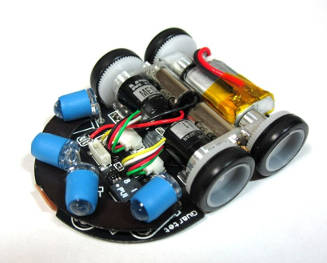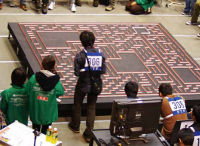| Micromouse In Slow Mo |
| Written by Lucy Black | |||
| Sunday, 24 November 2013 | |||
|
The Micromouse competition sounds easy - build a small vehicle to run a maze as fast as possible. It gives the impression that it's all dumb and a matter of "wall-banging" at speed. If you think it's all unsophisticated stuff then take a look at this slow mo video of a mouse navigating the maze. The Micromouse competition has been going as long as the microprocessor revolution. The first events were held in the late 1970s, but there were even some electromechanical contests before this. The task of running a maze is a combination of mechanical design and AI. The mouse first has to map the maze using a suitable search and optimization algorithm. As well as simply finding a route to the center, the mouse usually explores the maze further to see if the route can be improved. After working out a route, the mouse is set to re-run the maze as fast as possible.
The maze itself puts a physical constraint of the size of the mouse, i.e. it has to fit between its walls, and of course the mouse has to be self-contained. In most cases the fastest mouse is the mouse that wins and this generally means that from a spectator's point of view it can look like a mad dash from start to finish with no skill or finesse. Now take a look at the following two videos. The first is at normal speed and the second is a slow mo, videoed at 240 fps:
The mouse and videos are the work of RoboLabo, a competitor in the Japanese Micromouse competition, which is currently in progress - November 22-24. It is worth knowing that the real competition uses a much bigger maze than the demo mazes in the videos.
More InformationRelated ArticlesSpectacular Advances In MicroMouse Performance
To be informed about new articles on I Programmer, sign up for our weekly newsletter, subscribe to the RSS feed and follow us on Twitter, Facebook or Linkedin.
Comments
or email your comment to: comments@i-programmer.info
|
|||
| Last Updated ( Sunday, 04 June 2023 ) |




